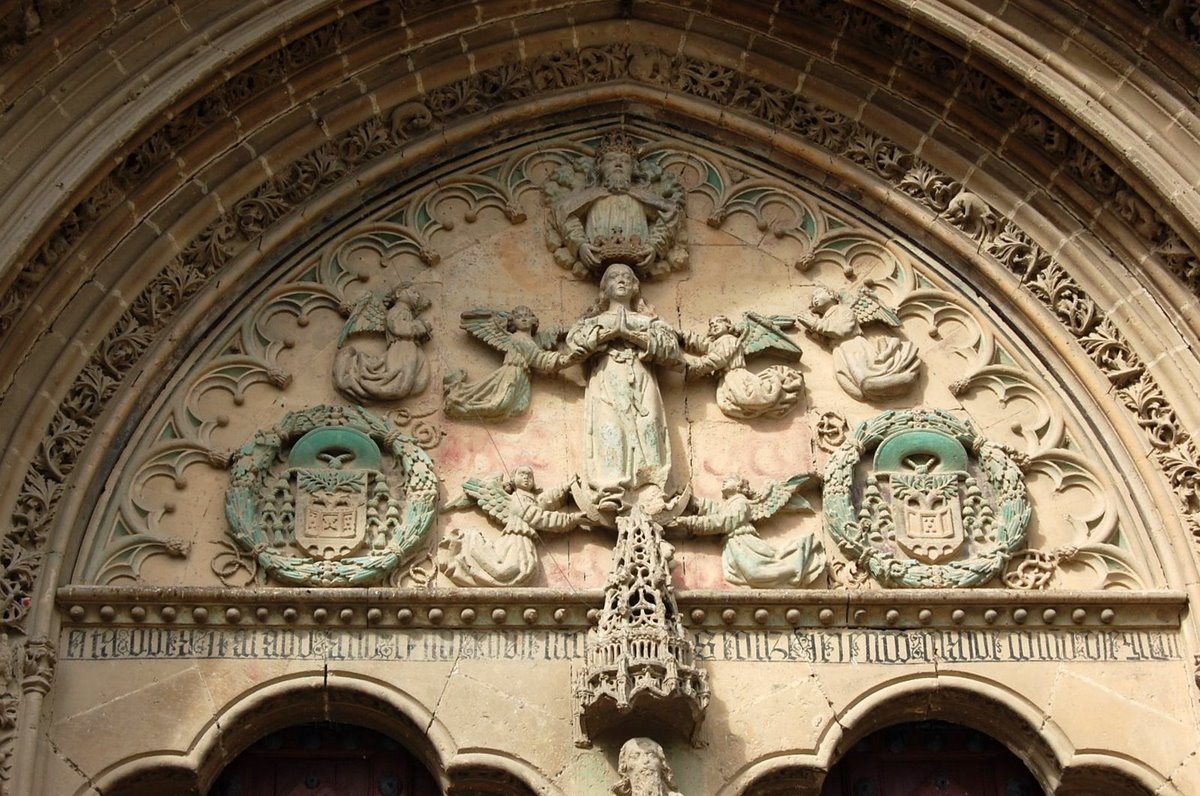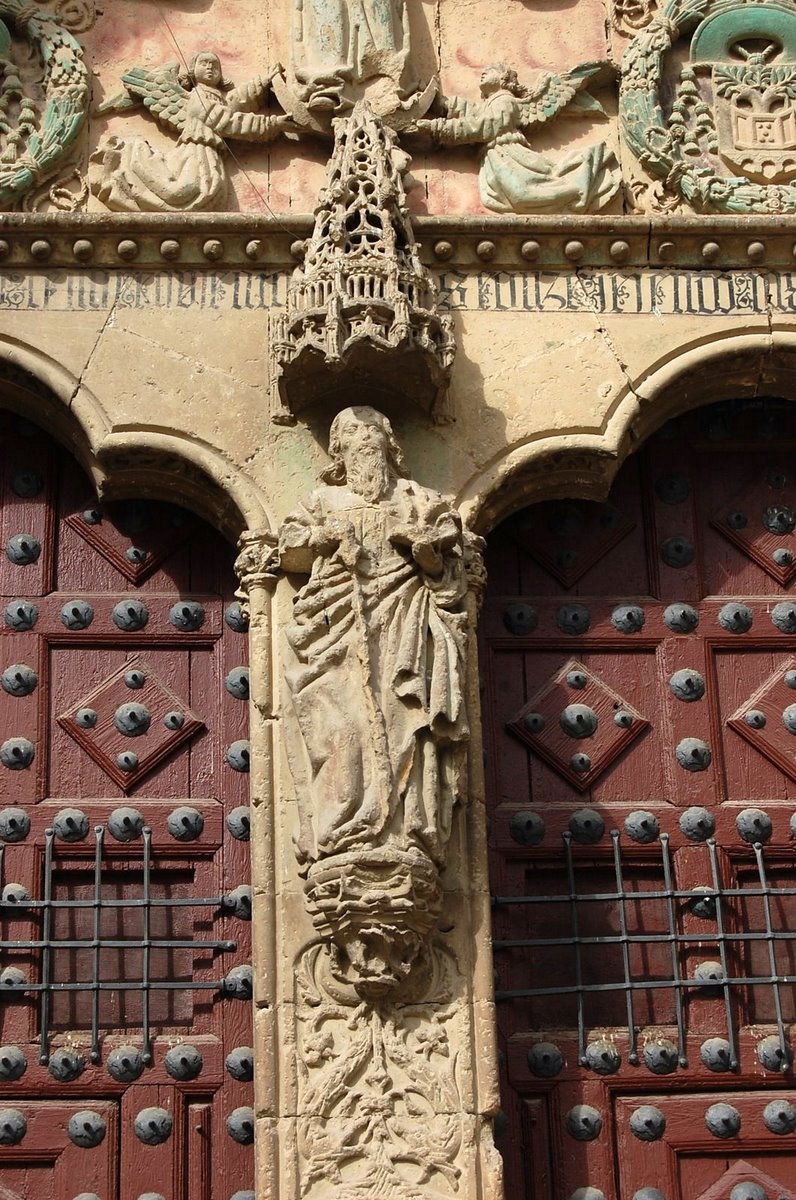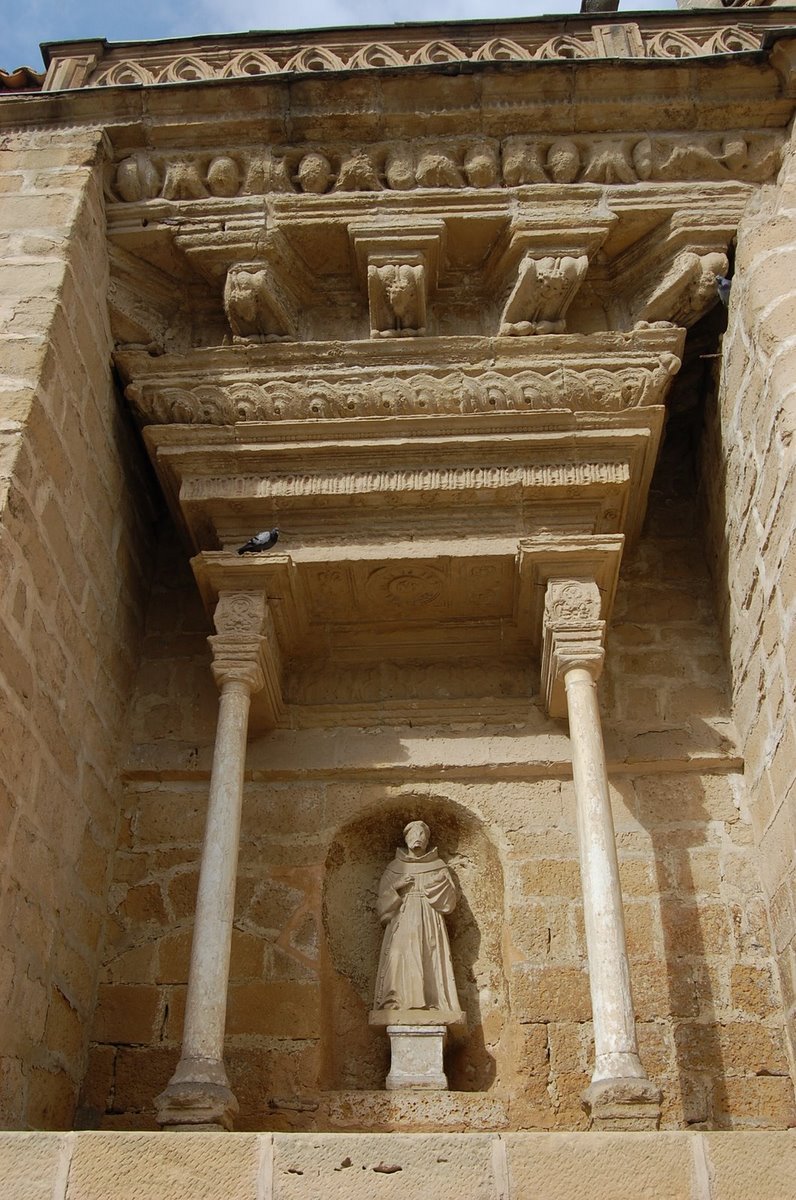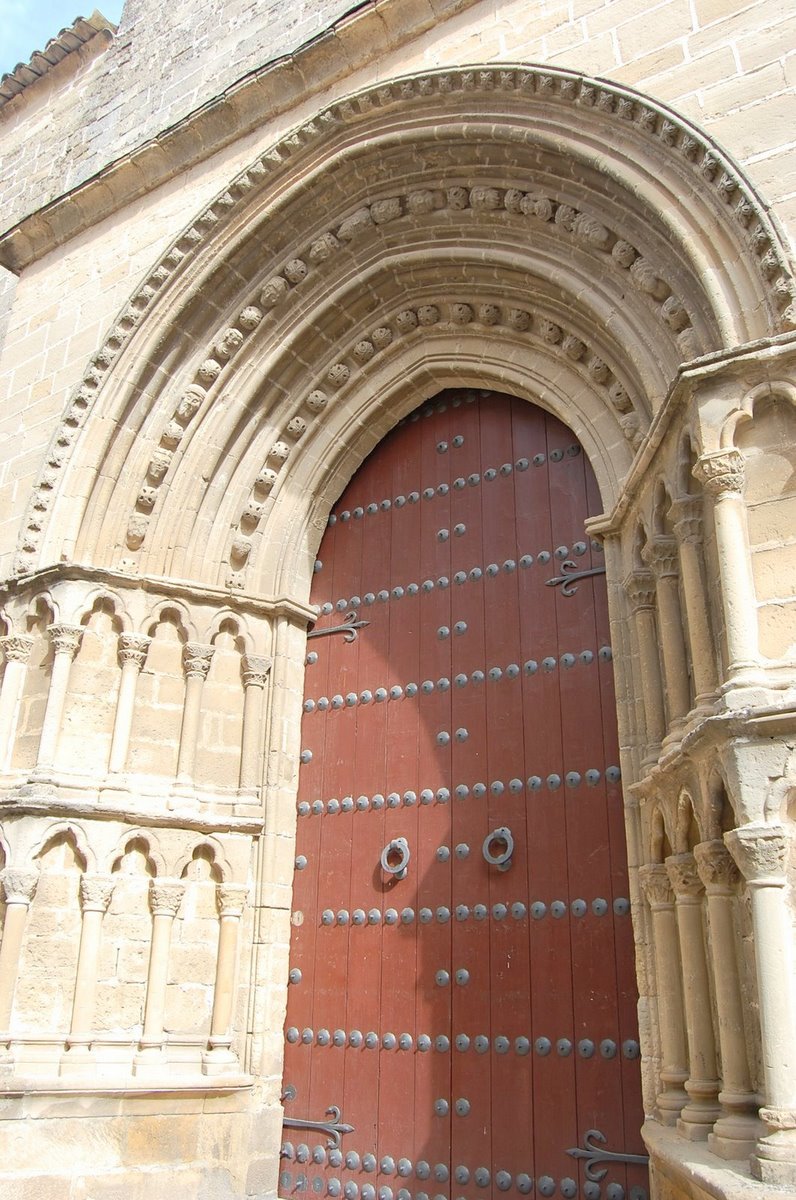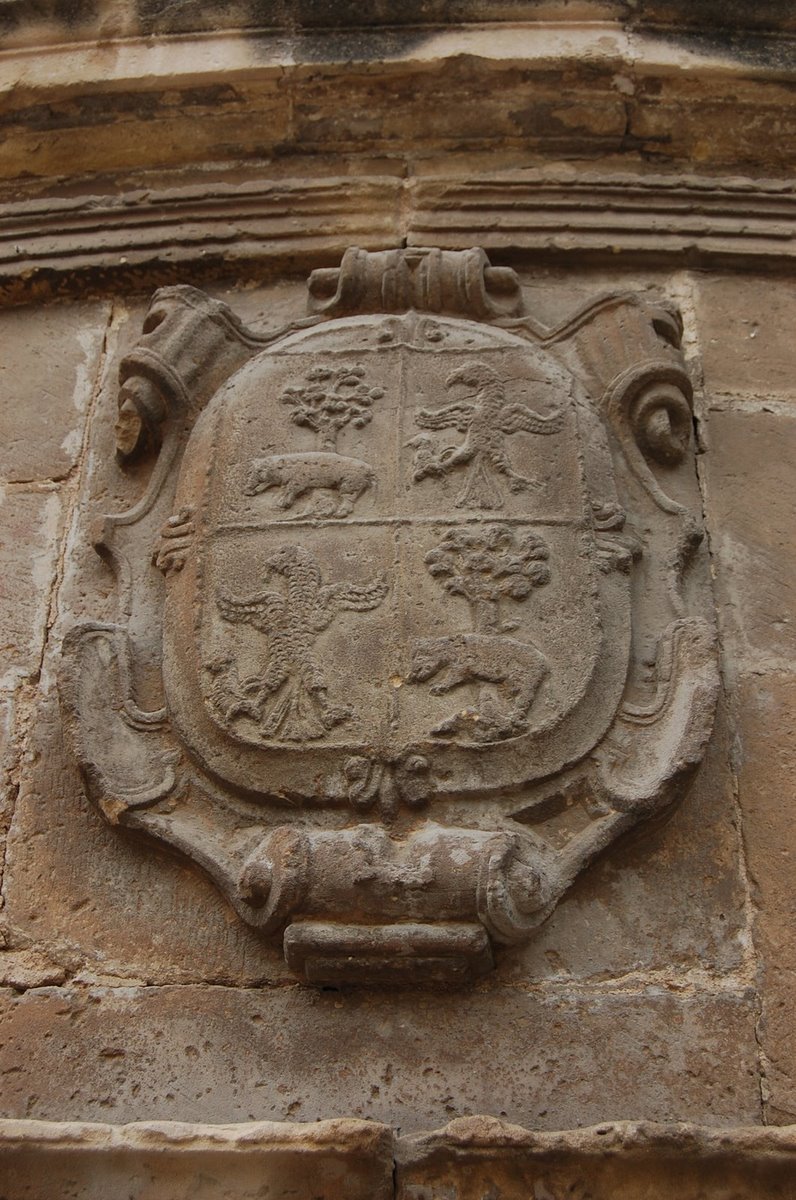Úbeda's Plaza 1st of May
was its market square going back at least to the
Moors souk (market). This
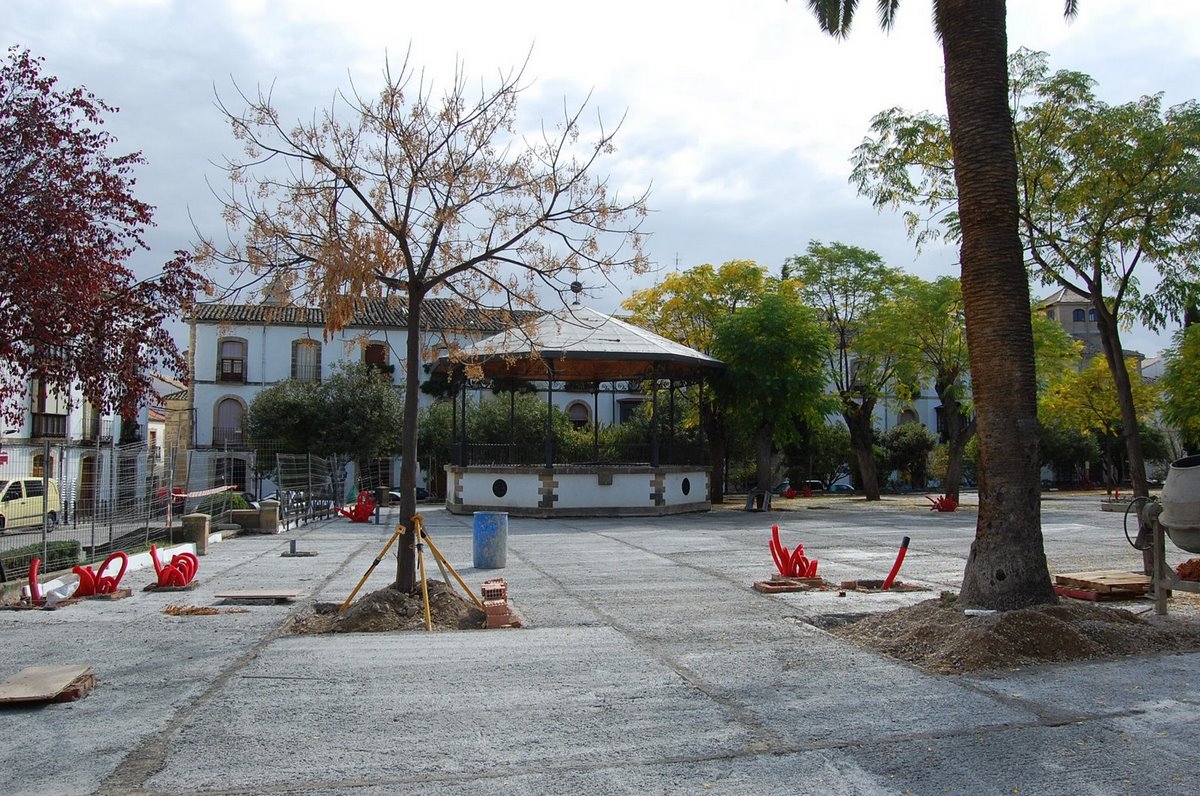
quite large space has at least two
important buildings, Saint Paul's church (inset in upper right above)
and its first town hall (inset lower left). It's
still called Market
Square by Úbedeños and was once the
site of bullfights and Inquisition "confessions."
Unfortunately, the square was closed for construction at
our visit. The band shell (pictured right) was in place
but the plaza's statue of St. John of the Cross was
probably away getting restored. Not to worry, several
more statues of this famous barefoot Carmelite
were within rosary distance of the
square.
St Paul Church
Most of the north side of this
large plaza is anchored by the primarily Gothic Iglesia
de San Pablo. Note below the upper gallery for watching
what goes on in the plaza. And above its Romanesque apse,
a most un-Gothic hexagonal tower sporting a bishop's
coat-of-arms, perhaps that of Don Alonso Suárez de
la Fuente del Sauce who raised the money for extensive
renovations starting in the early 1500s -- a time when
the secular nobles were trying to create Renaissances
palaces and the Bishops were generally staying with their
Gothic predilection.
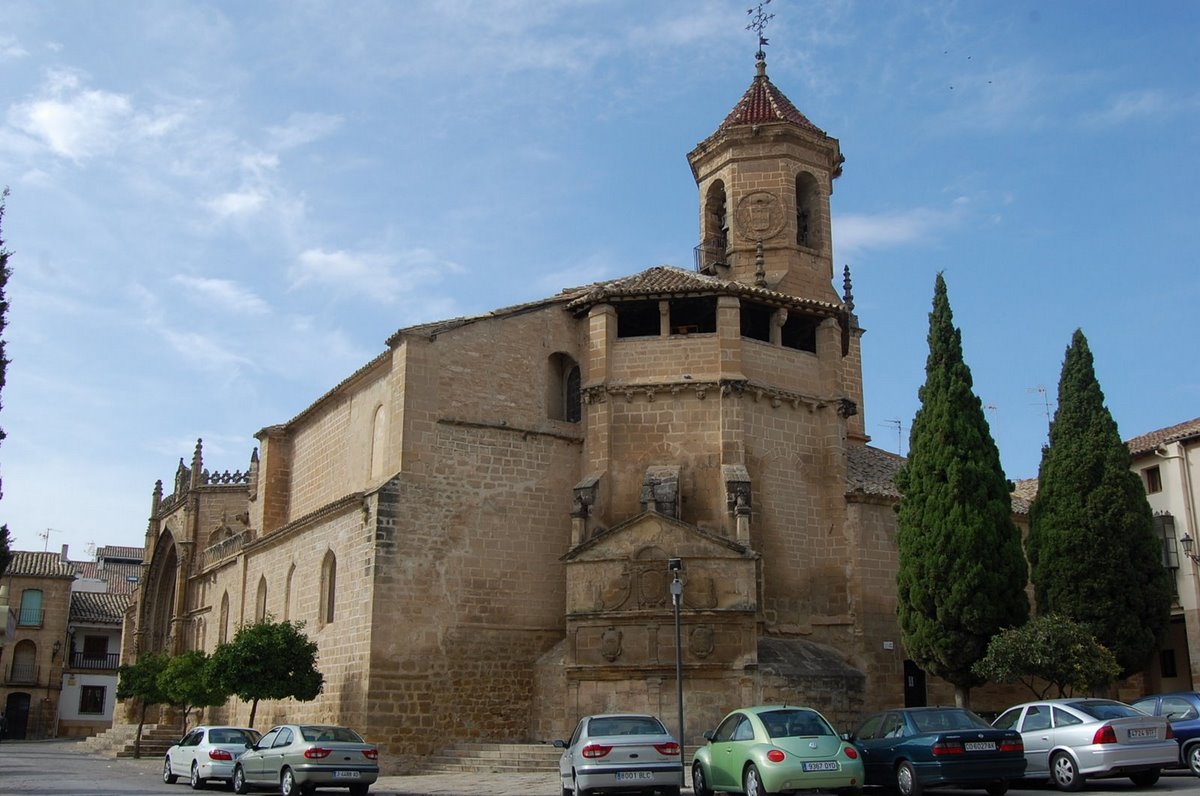
Dog’s breakfast anyong? Given its age, St. Paul's
is primarily Gothic with even some late Romanesque
features. Given that work
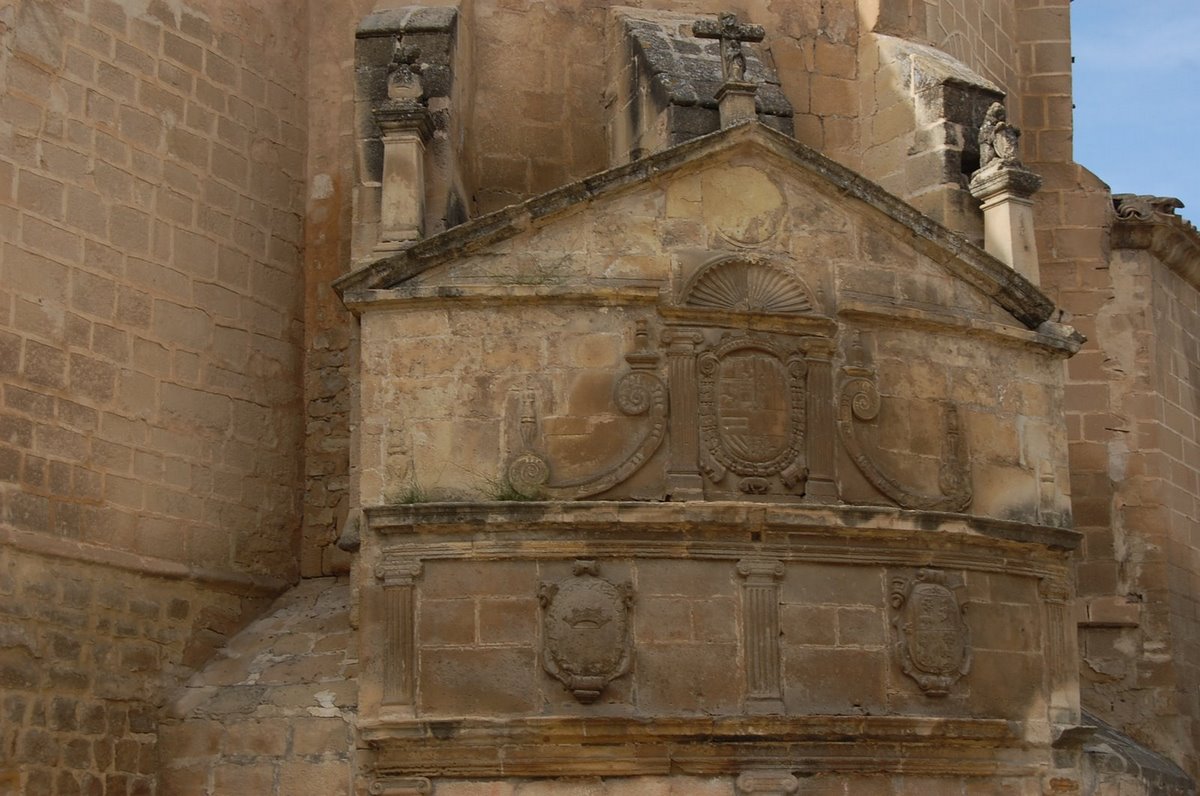 continued into the 18th century,
other styles have made their way into its stones. The
original church replaced one of theMoor's mosques which itself may
have replaced an early Visigoth church. Pretty much all
of that was destroyed during the 14th century civil war.
The Gothic base we see here rose sometime after
1368.
continued into the 18th century,
other styles have made their way into its stones. The
original church replaced one of theMoor's mosques which itself may
have replaced an early Visigoth church. Pretty much all
of that was destroyed during the 14th century civil war.
The Gothic base we see here rose sometime after
1368.
Gothic churches’ main doors are
usually on the west side but here (picture below) San
Pablo faces what was the town’s main plaza to its
south. This is a magnificent portal added in the 16th
century when most of the town was going Renaissance.
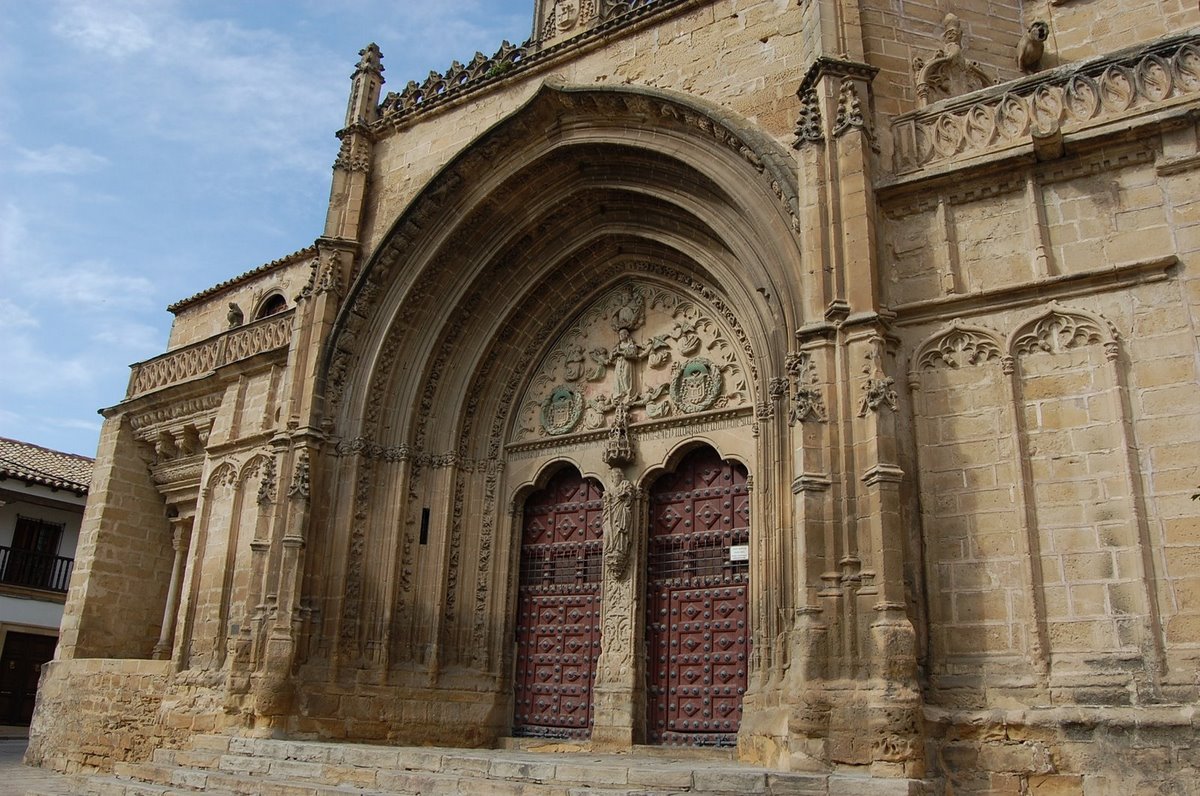
The tympanum (detail
below left) shows green traces of its original
polychromy (yes, Gothic masons painted their stone). Here
symmetric angels bring Mary to God the Father who will
crown her. Two of the funding bishops coats-of-arms frame
the lower angels. Note the stonework at the bottom of
this picture – good, but not as tight as what
Vandelvira have done. (Vandelvira did provide some of the
interior touches for St. Paul’s, however.)
Below Mary
under a stone canopy hangs
the church's namesake, St. Paul, in Gothic
rigidity
(pictured above right).
Just to the west of the main portal appears this large
recess (above
left)with Renaissance moldings called "El
Tabladillo" holding what looks to be a statue of St.
Francis in pretty bad shape. This apparently served as a
safe viewing point during bullfights held in the square
opposite. As patron saint of animals, would Francis
approve? At center we see the west door with its double
row of arches; it's the oldest entrance and shows
Romanesque traces. At right is an interesting
coat-of-arms we found on the exterior of San Pablo near
the north door. On diagonal axes we seem to have a pig
under a tree alternating with an exuberant bird of prey
holding what may be a lamb in his talons. Not what we'd
expect on a church. It may be the crest of Cardinal Don
Esteban Gabriel Medina (but usually cleric's crests are
capped by a hat).
Unfortunately, the triple-naved interior of San Pablo
was closed on our Sunday visit. Inside we missed some
noted local Renaissance grillwork, a chapel by
Vandelvira, and what appear to be gilded floats for
religious processions. However, the town council provides
a 360-degree video of the spacious Gothic interior for
those with the skills and time to do a little
downloading.
Click here to access the zipped
files.
The old town hall
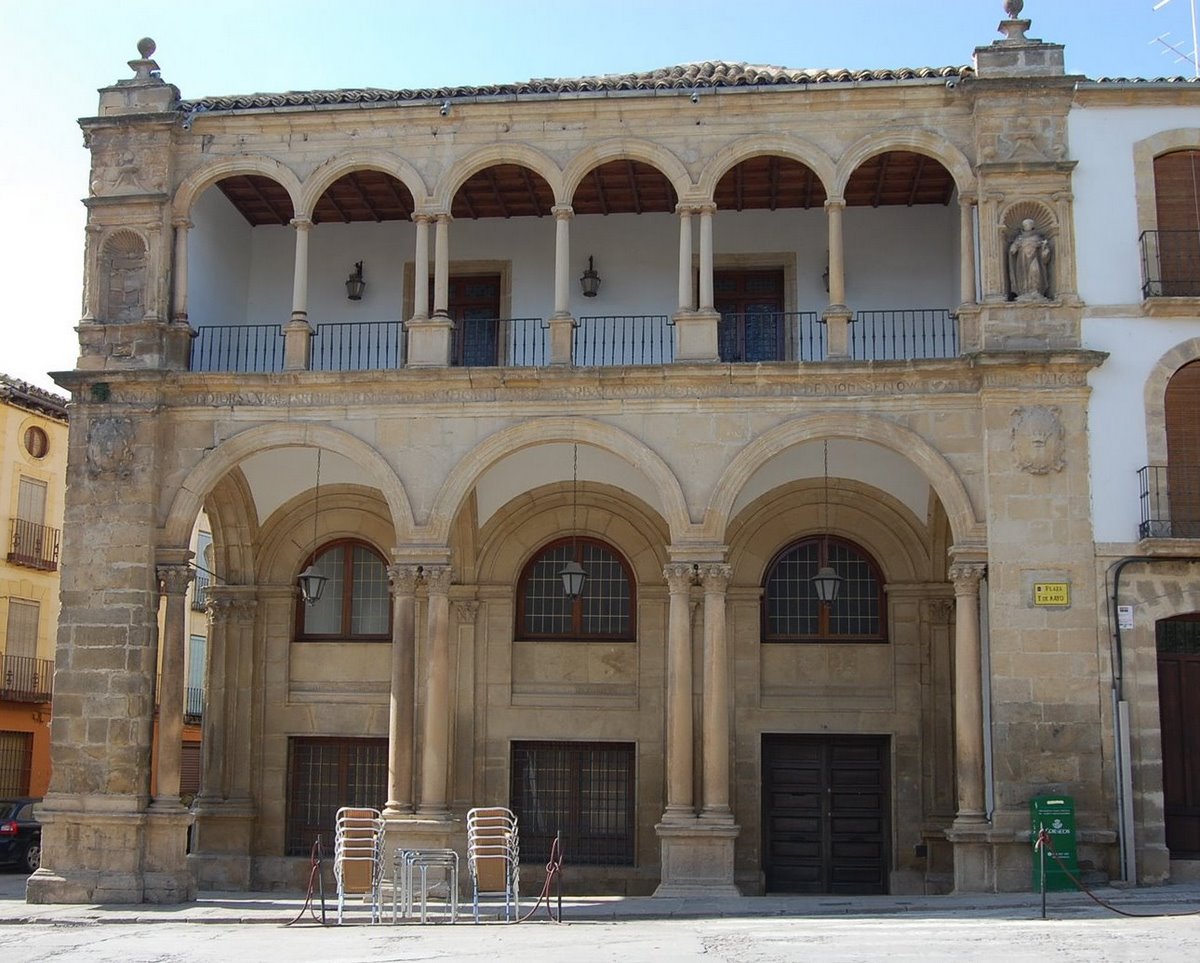
The little faded jewel of a building shown above was
Úbeda's first town hall and is today known as the
Palacio Antiguas Casas Consistoriales. Started before
Úbeda had its peak wealth, it took most of the 1st
half of the 16th century to raise construction funds.
Here we see the double-loggia facade that faces the old
market square with a Mirador gallery on the upper floor
to allow the town's fathers to watch over market
activity, festivals, and bullfights.
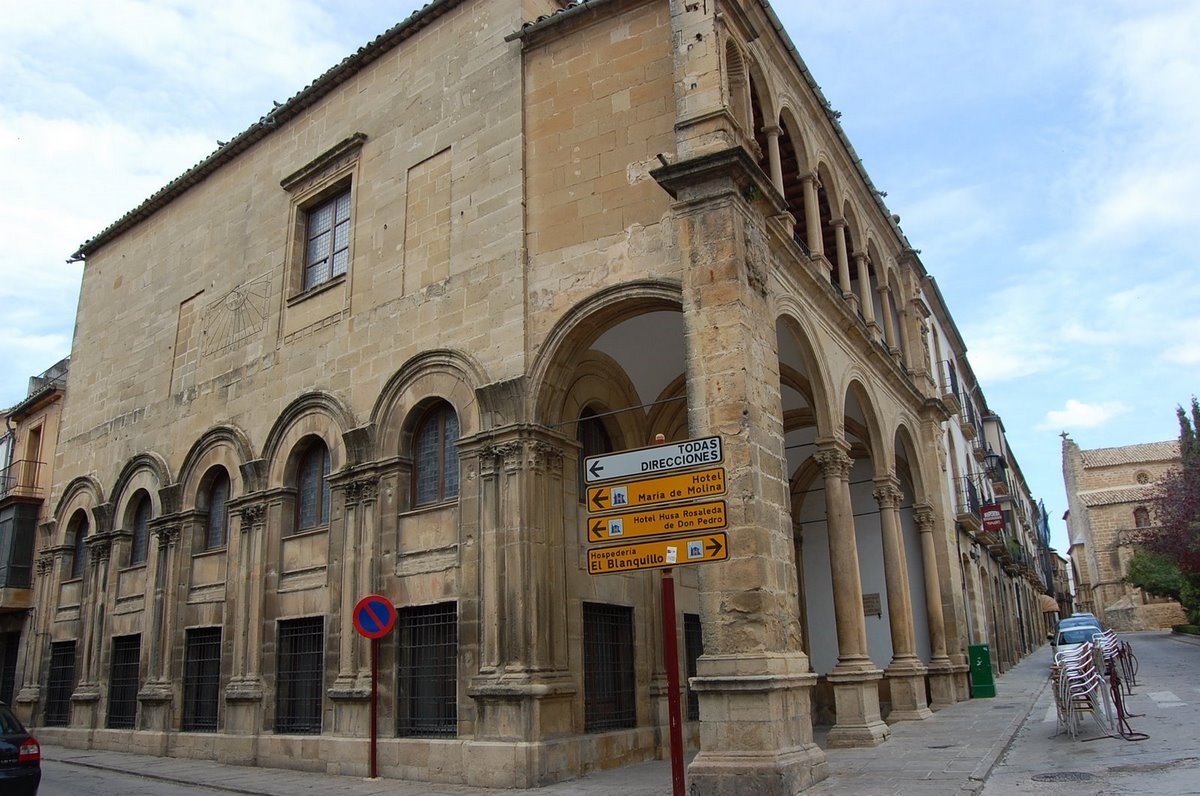 Corinthian columns hold up three
large arches at bottom, while the six at top are Ionic.
Missing is the saint in the niche at left, most likely
San Miguel, the town's patron. At right is Saint John of
the Cross, a temporarily local boy made very good. It had
to be added during the first remodeling as John lived in
the century AFTER this place was built. Below the niches
the town’s coats-of-arms is sorely in need of
restoration – the crowns inside of stars are barely
visible.
Corinthian columns hold up three
large arches at bottom, while the six at top are Ionic.
Missing is the saint in the niche at left, most likely
San Miguel, the town's patron. At right is Saint John of
the Cross, a temporarily local boy made very good. It had
to be added during the first remodeling as John lived in
the century AFTER this place was built. Below the niches
the town’s coats-of-arms is sorely in need of
restoration – the crowns inside of stars are barely
visible.
Today Úbeda's Palacio Antiguas Casas
Consistoriales is a music conservatory named after Maria
de Molina, an Úbedeña who was Queen consort
around 1300. Above is the south view with 5 arches -- and
what appears to be a non-working sundial on the upper
floor where two windows have been somewhat clumsily
blocked off. From this angle, it’s obvious that the
east façade was added on (starting in 1604). A
close look at the tops of the Corinthian columns shows
what may be the remains of arches leading outward from
this building over what is today the street (also named
after the Queen consort) which leads to the plaza with
the newer city hall which is much plainer but in better
shape. Unlike the impeccably restored buildings in the
magnificent Plaza Vazquez de Molina, this
Italian-Renaissance inspired building deserves a better
restoration – maybe like the one the more attentive
town gave the place during much of the 17th century
This steet takes us back to the city hall square and the
rest of town; before heading there,
let's backtrack to explore some of the highlights
of Úbeda eastern edge where the ancient
defensive walls and their entrance gates still stand.
Join us by
clicking here.
Please join us in the following slide show to
give Úbeda the viewing it deserves by clicking here.
|
|
|
|
Geek and Legal Stuff
Please allow JavaScript to enable word
definitions.
This page has been tested in Internet
Explorer 7.0 and Firefox 3.0.
Created on 15 February 2009
|
 |
TIP:
DoubleClick on any word to see its definition.
Warning: you may need to enable javascript or allow
blocked content (for this page only).
TIP:
Click on any picture to see it full size. PC
users, push F11 to see it even larger.
<
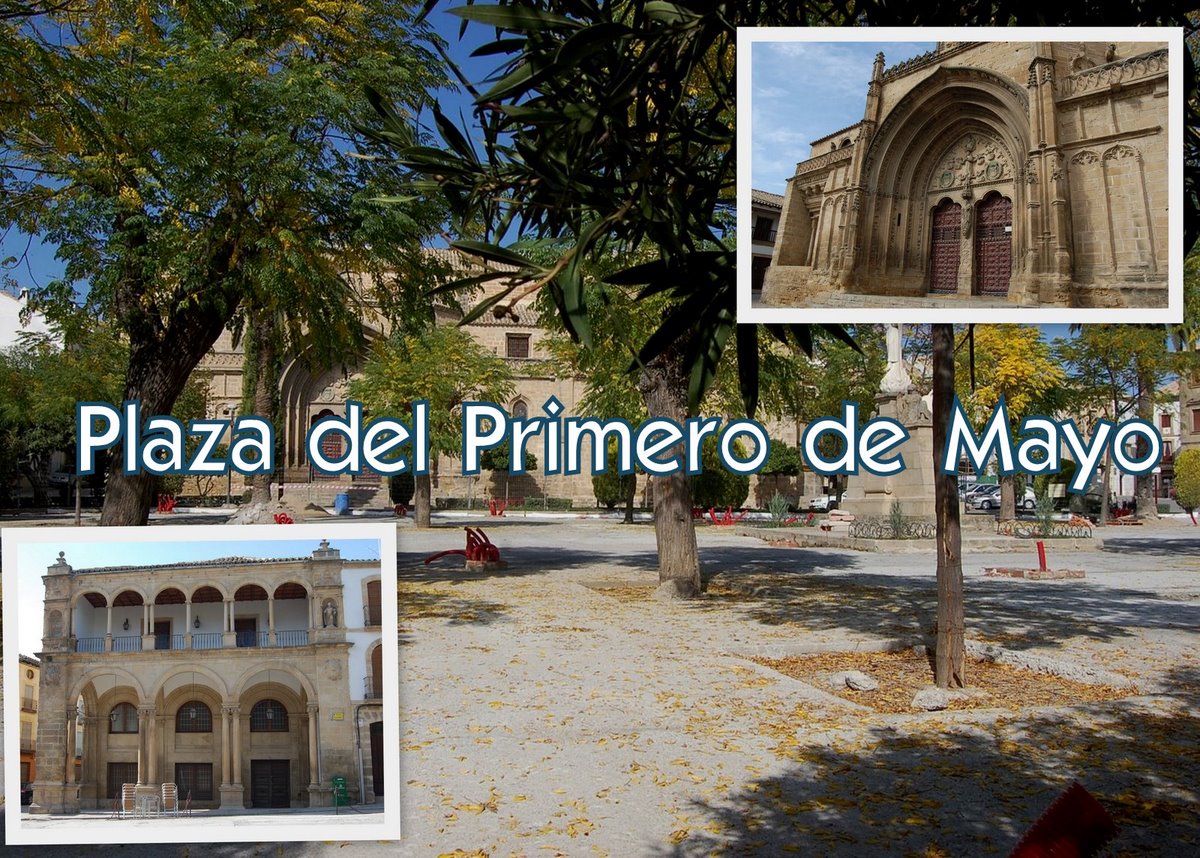


 continued into the 18th century,
other styles have made their way into its stones. The
original church replaced one of theMoor's mosques which itself may
have replaced an early Visigoth church. Pretty much all
of that was destroyed during the 14th century civil war.
The Gothic base we see here rose sometime after
1368.
continued into the 18th century,
other styles have made their way into its stones. The
original church replaced one of theMoor's mosques which itself may
have replaced an early Visigoth church. Pretty much all
of that was destroyed during the 14th century civil war.
The Gothic base we see here rose sometime after
1368.
